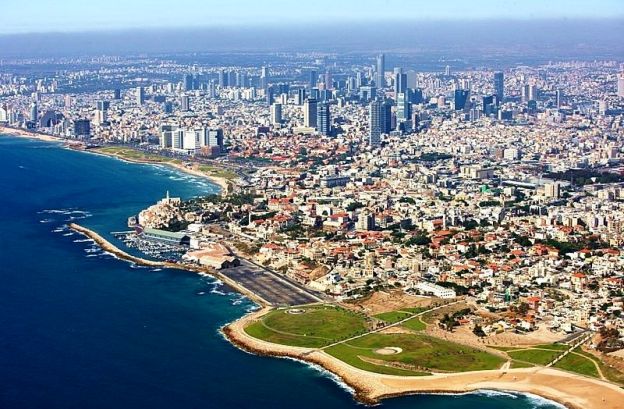The second largest city in Israel, Tel Aviv is situated along the Mediterranean coast. The history behind this rich metropolis is astounding. Originally known as Jaffa, the city dates back to 1470 BC, where an Egyptian pharaoh mentioned it in letters he wrote. It is also mentioned in the Bible, in the book of Jonah, and when referring to Solomon’s Temple and the Tribe of Dan. It is believed to have been a port for over 4,000 years. Here are some facts about this interesting Jewish city that is full of intrigue and culture.

1) The name Tel Aviv was given to the city in 1910 after much deliberation. The Book of Ezekiel says, “Then I came to them of the captivity at Tel-abib, that dwelt by the river of Chebar, and I sat where they sat, and remained there astonished among them seven days.” Abib or Aviv means “spring” in Hebrew, which symbolizes renewal. Tel describes an archeological site where layer upon layer of civilizations were built over each other.
2) Tel Aviv is located on land north of the original old city of Jaffa, where it was purchased from the Bedouins. Before this time, however, Jaffa had been owned by many countries, with archeological excavations from 1955 – 1974 revealing gates and towers from the Middle Bronze Age.
3) Excavations in 1997 and later unearthed sections of a huge brick wall that dated back to the Late Bronze Age and a temple with several dwellings that dated back to the Iron Age. Sections of buildings from other periods have been discovered also, including the Pharaonic, Persian and Hellenistic years.
4) It was not until the early 18th century that Jaffa began to grow as an urban center. This was shortly after the Ottoman government in Constantinople came in to stop the attack from the pirates and Bedouins and also guard the port. In the 19th century, however, Jaffa began to show real growth and the population went from 2,500 to 17,000 between the years of 1806 to 1886.
5) In April of 1909, sixty-six families of Jews set about to barter a portion of the land by lottery, using seashells. Each family’s name was written on white shells and the various plot numbers were written on gray shells. Thus, each family acquired a particular plot of land in a particular area that is located in the northern section of Jaffa. The families began to live and work in this area and within one year, many important streets, all sixty-six homes and a water system were constructed.
6) Unfortunately, political friction between the Jews and Arabs in Palestine continued to increase under British administration. In May of 1921, riots sprang up in Jaffa and many Jewish residents were killed. After this disaster, many of the Jews in Jaffa fled to Tel Aviv. The population now increased from 2,000 to 34,000 between the years of 1920-1925.
7) Tel Aviv became the more popular city for business while Jaffa began to slowly deteriorate as the center of commercialism. A master plan for the city was developed in 1925 that was soon accepted by the city council. The city continued to grow, but it did have tremendous financial hardship between the years of 1927 and 1930. The setback passed, however, as the city continued to grow.
8) With the Nazis take-over in Germany, many Jews fled to Tel Aviv, now bringing the population up to 150,000 in 1937. Within two years, that amount was up to 160,000, making up over a third of Israel’s total Jewish population.
9) The population of Tel Aviv had risen to over 200,000 residents when Israel declared her independence in 1948. The city served as a temporary center of political government until it was moved to Jerusalem in 1949. Many foreign embassies have remained in the Tel Aviv area, however, due to the international dispute over Jerusalem’s status. In 1950, the two cities of Jaffa and Tel Aviv officially united, and it was renamed Tel Aviv-Yafo, to maintain the recorded and historical name of Jaffa.
10) Since that time, Tel Aviv has continued to grow into a more moderate-minded city with the development of nightclubs and cafes. However, despite the disputes, wars, and setbacks, this growing metropolis continues to provide the world with tourist areas that provide non-stop entertainment, activity and education. In fact, the international tourism of Tel Aviv is often compared to the popular tourist cities of Barcelona and Miami. With more than forty-four hotels in Tel Aviv, the city lives up to its name – the city that never sleeps. Finding a hotel in Israel, particularly in Tel Aviv, is not difficult considering the many available choices.
With its active nightlife, culture and beauty, Tel Aviv is a city that has few dull moments. in the midst of museums, cultural and architectural sites, bus tours and other activities, tourists never have to worry about what to do next. The city boasts of a huge variety of restaurants, with both international and Israeli cuisine. There are also more than one hundred sushi restaurants in the city. Taking a trip to Tel Aviv is one that will take you down many avenues – from relaxation to an exciting nightlife – you will find it all here.

